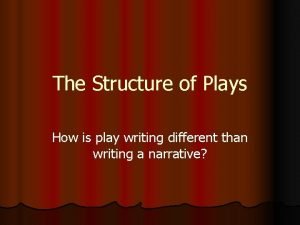The Plays Structure STARTER Most plays have acts




![End of Scene I BLANCHE: The boy--the boy died. [She sinks back down] I'm End of Scene I BLANCHE: The boy--the boy died. [She sinks back down] I'm](https://slidetodoc.com/presentation_image/c9387bdd246bb1206295456930c3ae8d/image-5.jpg)


- Slides: 7

The Play’s Structure STARTER: ‘Most plays have acts. Streetcar doesn't. Rather it is divided into eleven scenes occurring in chronological order and taking place between May and September. ’ Why do you think Williams may have chosen to use only scenes within his play? Extension: ‘The Poker Night’ is the only named scene, and was the original name for the whole play. Why do you think this scene is so pivotal to the drama for Williams?

The Structure It can be said that Streetcar utilises elements of the classical dramatic structure of crisis and climax. The bare bones of the piece fit numerous other plays in which the on-stage action is set in motion by the arrival of an intruder who invades and disrupts an apparently stable and harmonious world before being expelled, whereupon harmony is (more or less) re-established. There are 11 scenes in total which, arguably, can be used to parallel the state of Blanche's emotional and mental health. Create a graph that tracks Blanche’s mental health at the conclusion to each scene. Label plot points with significant factors relevant to the scene. Mental Equilibrium Time

No Acts What would the effect of these break points be on the audience? The original stage production placed the two intervals after Scene IV (The Poker Night) and Scene VI (Blanche’s date with Mitch) and it has been suggested that this model effectively divides the play into three sections: Scenes I – IV – set in early May, establish a mood of dark comedy Scenes V and VI – set on swelteringly hot August evening, are melancholic, nostalgic and romantic. Scenes VII – X – set on the afternoon and evening of Blanche’s birthday, 15 September, are powerfully dramatic, climatic and tragic Then Scene XI, set ‘some weeks later’, presumably early autumn, words as a kind of desolate tragic conclusion.

Dramatic Climax (AO 2 structure) Williams ends each of the 11 scenes with a ‘vivid punchline, startling tableau or arresting visual image’. Look back through the play. For each scene, write down how it ends and make a note of the effect of these scene endings on the audience watching, and our understanding reading it.
![End of Scene I BLANCHE The boythe boy died She sinks back down Im End of Scene I BLANCHE: The boy--the boy died. [She sinks back down] I'm](https://slidetodoc.com/presentation_image/c9387bdd246bb1206295456930c3ae8d/image-5.jpg)
End of Scene I BLANCHE: The boy--the boy died. [She sinks back down] I'm afraid I'm-going to be sick! [Her head falls on her arms. ] Finish this analysis of the closing stage directions: Within the closing stage directions to Scene I, Williams suggests that Blanche ‘sinks back down’ as her ‘head falls on her arms’. The use of verb ‘sink’ suggests…

Williams’ Intentions (AO 3) For Williams, a play had to do more than merely reflect life as it was; it should try to express some universal insight into the human condition. His modes of dramatic expression are thus many, varied and complex and his concept of ‘plastic theatre’ places as much value on non-literary and non-verbal elements of drama, such as sound, lighting, movement, setting and design, as it does on dialogue in terms of their ability to convey theme and character.

Why is this all important? AO 2 AO 3 – features of language, structure and form. Williams intentions through the use of plastic theatre and his stage directions; the way the play would be perceived by an audience considering the use of structure.












